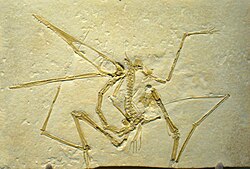Pterodactyloidea
| Pterodactyloids | |
|---|---|

| |
| Pterodactylus antiquus, Carnegie Museum of Natural History | |
| Klasifikasi ilmiah | |
| Domain: | Eukaryota |
| Kerajaan: | Animalia |
| Filum: | Chordata |
| Ordo: | †Pterosauria |
| Klad: | †Caelidracones |
| Subordo: | †Pterodactyloidea Plieninger, 1901 |
Pterodactyloidea adalah sebuah subordo pterosaurus berekor pendek. Catatan fosil mereka dimulai dari periode Jura Tengah. Merkea punah pada Peristiwa kepunahan Kapur–Paleogen, 66 juta tahun lalu, bersamaan dengan dinosaurus non-burung. Reptil terbang terkenal seperti Pterodactylus, Pteranodon dan Quetzalcoatlus berada pada subordo ini.
Pada 2014, sisa-sisa pterodactyloid terawal ditemukan di Tiongkok. Diberi nama Kryptodrakon, genus ini berasal dari 162.7 juta tahun lalu, membuatnya 5 juta tahun lebih awal daripada speimen-spesimen lainnya pada masanya.[1]
Studi terbaru menunjukkan bahwa kelompok ini lebih beranekaragam pada akhir periode Kapur daripada yang sebelumnya dianggap ilmuwan. pada awal 2010-an, beberapa takson pterosaurus baru ditemukan, yang berasal dari periode Kapur Akhir.[2][3] Penemuan-penemuan ini mencakup beberapa spesies pterosaurus kecil.[4][5]
Referensi
- ^ Andres, B.; Clark, J.; Xu, X. (2014). "The earliest pterodactyloid and the origin of the group". Current Biology. 24 (9): 1011–6. doi:10.1016/j.cub.2014.03.030. PMID 24768054. S2CID 18293296.
- ^ Andres B. & Myers T.S. 2013. Lone Star pterosaurs. Earth and Environmental Science Transactions of the Royal Society of Edinburgh. 103 (3–4): 1.[1]
- ^ Agnolin, Federico L. & Varricchio, David 2012 (2012). "Systematic reinterpretation of Piksi barbarulna Varricchio, 2002 from the Two Medicine Formation (Upper Cretaceous) of Western USA (Montana) as a pterosaur rather than a bird" (PDF). Geodiversitas. 34 (4): 883–894. doi:10.5252/g2012n4a10. S2CID 56002643. Diarsipkan dari asli (PDF) tanggal 2013-01-15. Diakses tanggal 2016-09-03. Pemeliharaan CS1: Banyak nama: authors list (link) Pemeliharaan CS1: Nama numerik: authors list (link)
- ^ "Does morphology reflect osteohistology-based ontogeny? A case study of late Cretaceous pterosaur jaw symphyses from Hungary reveals hidden taxonomic diversity" (PDF). Paleobiology. 40 (2): 288–321. 2014. doi:10.1666/13030. S2CID 85673254.
- ^ Elizabeth Martin-Silverstone; Mark P. Witton; Victoria M. Arbour; Philip J. Currie 2016. A small azhdarchoid pterosaur from the latest Cretaceous, the age of flying giants. Royal Society Open Science. 3 (8): 160333. doi:10.1098/rsos.160333.














